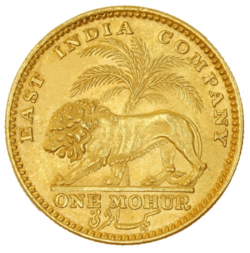Mohur

A Mohur is a gold coin that was formerly minted by several governments, including British India and some of the Princely States which existed alongside it, the Moghul Empire, Nepal, and Afghanistan. It was usually equivalent in value to fifteen silver rupees. It was last minted in British India in 1918, but some princely states continued to issue the coins until their accession to India after 1947.'Mohur was also used during mughal period ' Similar coins were also issued by the British authorities in denominations of 2/3 Mohur (10 Rupees) and 1/3 Mohur (5 Rupees), and some of the Princely States issued Half Mohur coins (equal to 7 Rupees and 8 Anna).
The Mohur coin was first introduced by Sher Shah Suri during his rule in India between 1540 and 1545 and was then a gold coin weighing 169 grains. He also introduced copper coins called Dam and silver coins called Rupiya that weighed 178 grains.[1] Later on, the Mughal Emperors standardized this coinage of tri-metallism across the sub-continent in order to consolidate the monetary system.
Etymology
The word 'Mohur' or 'Mohor' is the Persian word muhr, which means 'seal' and is cognate with the Sanskrit word mudra which also means 'seal.'
See also
References
- ^ Mughal Coinage at RBI Monetary Museum. Retrieved on May 4, 2008.
External links
